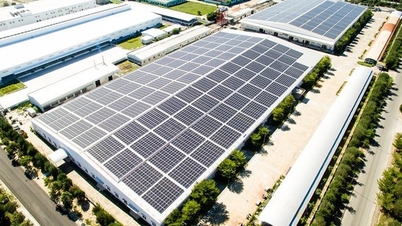If in the early 2000s, the whole country only had about 39,000 operating enterprises (according to the General Statistics Office), by the end of 2023 this number had increased 23 times, reaching 921,372 enterprises, of which the private sector accounted for the majority.
The private sector generates 51% of GDP
In the period 2017-2022, compared to the State-owned enterprise sector and the foreign-invested enterprise (FDI) sector, private enterprises are the fastest growing and strongest sector. The number of private enterprises increased from 541,753 to 710,664 enterprises, an increase of nearly 169,000 enterprises in just 5 years, an average of more than 33,000 new enterprises per year. Meanwhile, FDI enterprises only increased from 16,178 to 22,930 enterprises (an increase of 41.7%), while State-owned enterprises decreased continuously, to only 1,861 units, by 2022, according to the Vietnam White Book for the period 2017-2022.
The rapid increase in number and proportion shows the increasingly important role of the private business sector in the economy .
Not stopping there, business efficiency has also improved significantly. Data by 2022 shows that private sector revenue reached VND20.7 trillion, profit VND555,200 billion, a much higher contribution than in previous periods.
In terms of its role in growth, the private sector has created 51% of GDP, contributed more than 30% of the State budget, and is also the largest employer, with about 9.1 million employees, accounting for 59.2% of the total number of employees in enterprises.
These figures show that the private sector is not only an overwhelming force in terms of scale but also the main driving force of economic growth. From being fragmented and weak, the private sector has now risen to become a pillar, contributing more than half of GDP and gradually asserting its role as the "backbone" of the economy.

The number of private enterprises increased sharply (Photo: DT).
Breaking the "curse" of two Vietnamese businesses not being able to go together
However, there are still many barriers for private enterprises to fully develop their capacity and contribute to the overall development of the economy. In particular, the role of private enterprises as "leading cranes" is emphasized.
Initiated by Committee IV and the business community, with the support of the Government , the model of "Public - Private Joint Nation Building" was born to maximize the mobilization of social resources.
At the recent Vietnam Private Economic Panorama 2025 meetings, the parties clearly identified two pillars: quick action and long-term strategic mechanism. In particular, with quick action, from 2025, the ViPEL 20-200-2,000 portfolio will be deployed with the targets of 20 national-level projects (infrastructure, core technology, new energy, etc.); 200 local-level projects (logistics, human resources, regional advantages); 2,000 grassroots-level projects (high-tech agriculture , community tourism, etc.).
ViPEL's core force, coordinated by Board IV (public-private bridge), the Executive Council includes leaders of large corporations such as FPT, Sovico, VinaCapital, U&I, Geleximco, PNJ...
Mr. Vu Van Tien - Chairman of the Board of Directors of Geleximco Group - commented: "We have the intelligence and ideas, the problem is how to act in difficult circumstances. Instead of 10 people doing it, if a million people do it together, it will become a movement." According to Mr. Tien, the business alliance needs to be determined to promote the goal of increasing the localization rate and developing supporting industries in the next 5 years.
The question is: “How can the 96% of the private sector, which are small and medium-sized enterprises (SMEs), join the common game? Or will they be left behind?”
Responding, Ms. Pham Thi Ngoc Thuy - Director of the Office of Private Economic Development Research (Department IV) - said that this was also the first question raised when establishing ViPEL. Ms. Thuy affirmed that ViPEL absolutely emphasizes 2 "NOs", including "NO" being established for show, to run media images; "NO" connecting dozens of people just to serve the interests of large business groups.
And to fulfill that commitment, ViPEL must solve the curse of two Vietnamese enterprises never being able to go together. At ViPEL, a core enterprise will go with an SME according to the mechanism of the big leading the small. In which, the big enterprise will receive tasks, targets and orientations on common implementation with the small enterprise.
Desire to be recognized, to be empowered

Vietnamese private enterprises aim for the goal of public-private nation building (Photo: DT).
Ms. Nguyen Thi Phuong Thao - Chairwoman of Sovico Board of Directors - believes that many Vietnamese private enterprises have the capacity to come up with breakthrough solutions, contributing not only to the domestic economy but also to the region. At the same time, they also want to be recognized appropriately.
Ms. Thao emphasized that Resolution 68 of the Politburo affirmed that the private economy is the driving force for growth. "Therefore, this is the time for private enterprises to take the lead in taking action, participating in national projects and programs that were previously stuck in mechanisms," Ms. Thao said.
However, the current weakness is that Vietnam still lacks a strong public-private coordination mechanism, as well as a comprehensive strategy for the private sector to participate in solving the country's "big problems". To turn the policy into reality, more specific and clear regulations are needed.
In fact, the presence of the private sector is increasingly expanding, especially in key areas. Vingroup stands out with VinFast in electric vehicles, VinSpeed in green transport infrastructure, VinMotion in multi-purpose robots and VinEnergo in renewable energy. Other corporations such as Coteccons, Hoa Phat, Thaco also participate in major projects such as Long Thanh Airport or the North-South Expressway. FPT affirms its role in digital transformation, cloud computing and AI.
Not only stopping at traditional industries, many private enterprises have also ventured into new fields such as digital assets, blockchain and cryptocurrency exchanges - showing the pioneering and innovative aspirations of this region.
Source: https://dantri.com.vn/kinh-doanh/tao-ra-51-gdp-khoi-tu-nhan-khat-khao-duoc-trao-quyen-duoc-cong-nhan-20251003095426584.htm


![[Photo] Students of Binh Minh Primary School enjoy the full moon festival, receiving the joys of childhood](https://vphoto.vietnam.vn/thumb/1200x675/vietnam/resource/IMAGE/2025/10/3/8cf8abef22fe4471be400a818912cb85)




![[Photo] Prime Minister Pham Minh Chinh chairs meeting to deploy overcoming consequences of storm No. 10](https://vphoto.vietnam.vn/thumb/1200x675/vietnam/resource/IMAGE/2025/10/3/544f420dcc844463898fcbef46247d16)






















































































Comment (0)